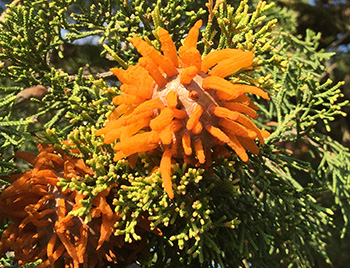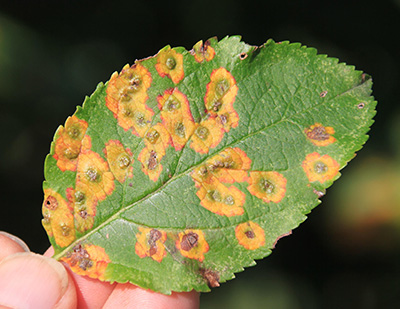Cedar-apple rust: A tale of a fungal disease with two hosts
Cedar-apple rust is a fungal disease found on cedar and apple trees, and affects each host differently.

If you look carefully, cedar-apple rust has a hyphenated name. This is because the disease has two hosts or victims, and it whacks one more severely than the other. If the expression “two to tango” was applied to cedar-apple rust, it could be “two to tangle.” Cedar-apple rust affects the two hosts differently at different times of the year, but for this disease to happen, there must be two hosts.
Cedar-apple rust on cedars
The eastern redcedar or Juniperus virginiana has a wide growing range and is found on the eastern half of the U.S., stretching from Maine to Louisiana. Michigan has many of these volunteer evergreens, mainly growing in alkaline soils.
In the spring, following a warm rain in late April into May, cedar-apple rust galls explode into a colorful display. Calls to the Michigan State University Extension garden hotline start coming in as people are amazed and sometimes dismayed at the orange, slimy, starfish-like things hanging in their trees. They either believe the trees are blooming or an alien has left them an unwanted gift.
Eastern redcedars have small, woody, brown growths of twigs from the fungus that grow slowly each year. These look like little deformed golf balls with many tiny dimples on the surface. The galls could range from 0.375 inch to over 1 inch in diameter. The galls sit for almost the entire year and are very inconspicuous, but following a warm rain in the spring, those little dimples on the galls produce multiple orange telial horns that are gelatinous and cover the gall completely. They look like floppy flower petals or slimy fingers. The orange color of the telial horns can vary from intense to a pale color. The telial horns can dry down and rehydrate several times when there has not been enough rain.
With dry weather, the telial horns dry up and drop off. By then the cedar-apple rust spores have floated away. For the eastern redcedar, the damage is slight, usually restricted to woody, deformed galls. But for apples, it is a far different story.


Telial horns emerging from cedar-apple rust galls. Photos by Patrick Voyle.
Cedar-apple rust on apples
Apples and crabapples can be negatively affected by cedar-apple rust. Genetically, apples and crabapples are kissing cousins and share in many disease and insect problems. Cedar-apple rust spores float away from the eastern redcedar’s telial horns and hope for a happy home on an apple or crabapple leaf. Small, yellow spots on the upper surface of the leaves appear shortly after the trees bloom. Spots gradually enlarge and become yellow-orange-red. The spots often have a bright red border.
Small, raised, black dots form in the center of the leaf spots on the upper surface of the leaves as the leaf spots mature. Very short, finger-like, fungal tubes protrude from the lower surface of the leaf directly below the spot. The fungal tubes appear to be fringed when they open at the tips. Yellow to orange powdery spores are released that float in search of an eastern redcedar. Apple trees may defoliate early or spots may develop on the surface of the apple, affecting the quality.
There are also several other similar Gymnosporangium rust fungi that affect hawthorn, quince, mountain ash, serviceberry, cotoneaster, pear and chokeberry. However, eastern redcedar is the host-culprit.

Cedar-apple rust symptoms on apple leaf. Photo by James Chatfield, Ohio State University, Bugwood.org.



 Print
Print Email
Email